

Back and forth, hither and yon – whether on my habitual trajectory between Touraine and Paris or further afield… destinations, encounters, events and observations I can’t resist sharing.

In Catholic parishes where I attended mass before moving to Orbigny, Christmas and Easter services were the big draw, but in rural Touraine, it’s Palm Sunday that really fills the pews. Considering it’s a lengthy service including the longest gospel reading of the year, I was amazed to see our typically sparsely filled church packed to capacity with men, women and children clutching bunches of boxwood clippings. Among the faces were avowed agnostics and vociferous anti-clerical types whom typically cross the threshold only for a funeral. This wasn’t about an excuse for dressing up, since Sunday go-to-meeting preening isn’t something the French go for even on holidays, with the exception of a wedding.
I suspected the swell in attendance was linked to a primeval sentiment beyond piety – the power of ingrained tradition and superstition to overpower cynicism and skepticism. But why boxwood instead of palm fronds?
In French, the feast is called Dimanche des Rameaux (Sunday of Branches). No mention of Palms. Boxwood, or buis, is a hardy evergreen plant that requires little watering and thrives in the alkaline clay soil of the region. You find it throughout Touraine, growing as a tree in the forest, a trimmed hedge or bush in cottage potagers, or sculpted into fantastic topiaries in chateaux gardens. Thus it’s readily available, unlike palms imported from the southern Mediterranean. In the UK and US, pre-blessed palms, typically woven into the shape of a cross, are distributed as congregants exit the church. Here we hold up boxwood cuttings from our gardens (or a supply set out on a table by the entry of the church), as the priest walks up and down the aisles blessing the congregation with holy water.
A few years back, while out riding my horse, I came across a farmer and his wife on their knees planting a sprig of buis in the plowed earth at the corner of their field. The spot is a local landmark known as Les Trois Croix, for three crosses erected at an intersection of four fields, where the boundary limits of three villages meet. It’s also the highest point in the county, and seemed an apt setting for a ceremony with echoes of pagan ritual. That was my aha moment and confirmed my hunch about the superstitious appeal of blessed buis. Read More »
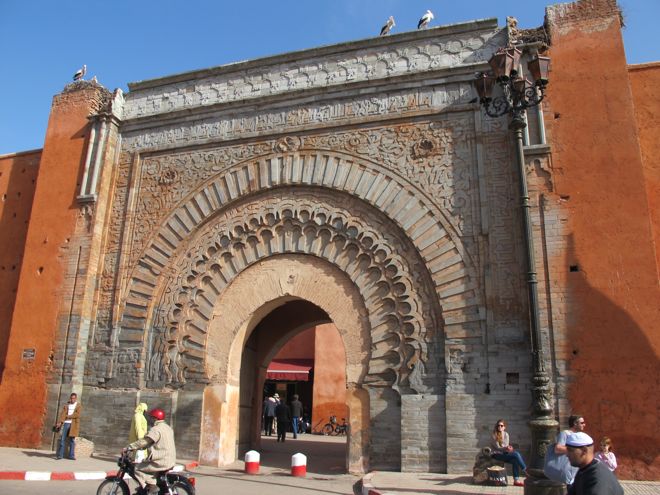
It didn’t take long for my eerie premonition of Magreban Revolution to play out in Tunisia and now Egypt. Morocco could well be next. I was riveted by the surge of protests which erupted in Tunisia the week of our return. They gained astonishing momentum, prompting the clandestine flight of Ben Ali, the autocratic, unelected president, in what Tunisians are calling their ”Jasmine Revolution”. Ben Ali, who ousted Tunisia’s popular post-colonial president in 1987, had been preparing a gilded retirement in France, where he owns sumptuous properties in Paris, the Cote d’Azur and Courchevel. He was refused the right to land here and members of his immediate family, already in France, were told to leave. So much for that pipe dream.
The mood in France is supportive of the Tunisian people’s emancipation. The Sarkozy government took heat for protracted silence throughout the protests, then proposing support to help quell violence. Most took that as a sign of support for Ben Ali rather than a strategy to avert violence used against protesters. The police fired on crowds and there were scores of deaths. Hard for the French administration to stage a graceful about-face after positioning Ali as a close friend, putting up with his despotic, corrupt rule, because he squashed Islamic opposition parties and claimed the healthiest economic growth record in Africa. Ali was hardly a comic book villain like Saddam Hussein, but has plenty in common with Permanent President Mubarak in Egypt where freedom of speech and true political opposition are also forbidden – as we can no longer ignore.
Morocco’s Royal Highness, despite his seeming popularity, has reason to be nervous. The domino effect could take off as it did in formerly communist Eastern Europe. The fact that Mohammed VI’s portrait is ubiquitous in commercial establishments throughout Morocco can be interpreted as a gesture of fear rather than fealty.
Geopolitics aside, I did promise to share visit recommendations to the Rose city. The reaction of French friends to our Marrakech holiday was a chorus of, “It’s nothing like it was… isn’t the real Morocco… Morocco à la Française.” But hey, french tourists flock to New York and Miami – which are hardly representative of America’s heartland. Key to Marrakech’s appeal is the alluring cocktail of cosmopolitan sophistication, exoticism and a whiff of decadence – out of your cultural comfort zone without being overly disorienting or dangerous.
If you read French (and even if you can’t), pick up a free copy of the monthly official Marrakech Pocket Guide, distributed in hotels and restaurants. It has a calendar of events, most of the addresses you’ll need grouped by category, plus ads for many good restaurants, cafes and shops.
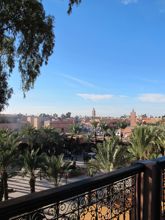 |
 |
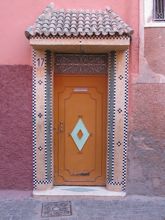 |
 |
 |
 |
 |
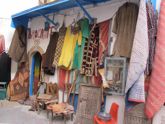 |
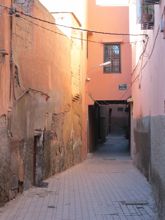 |
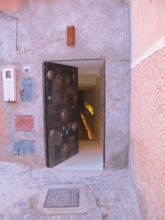 |
 |
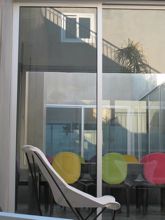 |
 |
 |
 |
 |
 |
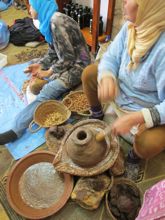 |
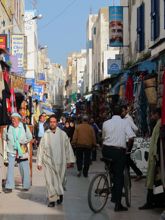 |
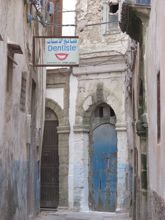 |
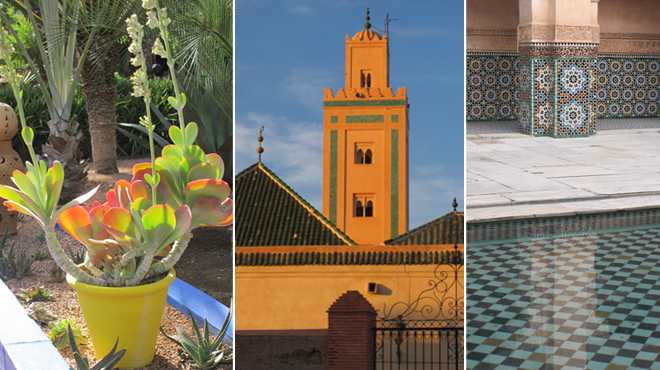
Just back from Marrakech celebrating New Year with family. It was my third time there (prior trips were sixteen and thirty years ago), but first chance to explore a full week. It’s changed considerably since 1994 – the transformational pace much faster than between my first two visits. Loss of authenticity is somewhat compensated by a boost in creature comforts.
The resonating experience of this trip was a flagrant disconnect between codes of dress and comportment within the walls of the medina and outside in the former French quarters – Guéliz and Hivernage west of the old town. Shuttling back and forth induces microseism culture shock.
We rented a riad in the Kasbah section of the Medina, next to the Mosque, Saaidian Tombs and Royal Palace – a neighborhood where alcohol is verboten, most women wear a headscarf if not a veil, and both sexes never expose a bare arm or leg. The scene is very different around Guéliz Plaza in the Zara, Mango and Etam fast fashion chain stores – where Moroccan women wear tight jeans tucked into high healed boots and toss around manes of hair. Neighborhood clubs and restaurants like Café de la Poste, Lotus, Jad-Mahal and Comptoir exude a glitzy San Tropez party vibe, with pulsating music and extensive cocktail menus.
Our driver/guide Mohamed, claimed that a third of tourists never penetrate the Medina and remain sequestered in outlying resorts, playing tennis or golf and lounging around the pool.
I left with an eerie premonition that Marrakech 2011 has much in common with Havana circa 196O, or Beirut 197O, before Revolution and Civil War crashed their parties. Perusing Nassim Nicholas Taleb’s The Black Swan: The Impact of the Highly Improbable may have gotten to me (despite an inability to slog through it). The Lebanese born author describes how well connected family and friends were sideswiped by the cataclysmic changes brought on by civil war and hovered in deluded exile, anticipating imminent return to life, as they knew it. Ditto for Cuban elders in Miami.
There’s also a whiff of Dublin’s ghost estates. If you drive out into the Palmeraies, resort properties and golf courses are going up cheek by jowl. It doesn’t take more than a few miles of cruising to detect a threat of serious over capacity. Legislation was recently passed barring foreigners from purchasing property that isn’t part of a development. It seems individual investors were jilting politically connected developers for a crumbling riad or rural kasbah. Like diaspora Irish lured during the Celtic tiger bubble, Marrakech real estate is heavily promoted to Beurs and Moroccan born Pieds Noirs. Ads at the airport pitch “return to your roots” investment opportunities “your holiday home for 100,00 dirham” (roughly 9,000 euros).
Grim foreboding aside, you can have plenty of fun in Marrakech. A dividend of steady tourism and satellite dish globalization, is a reduction in the onslaught of proffered wares and services, plus women are not as heckled with “hey gazelle” (although my daughters are a better judge of that). Read More »
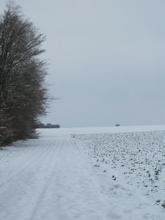 |
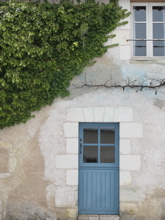 |
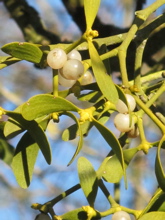 |
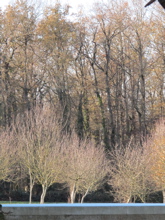 |
 |
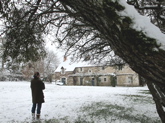 |
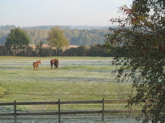 |
 |
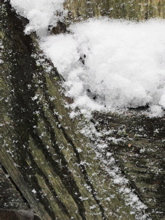 |
 |
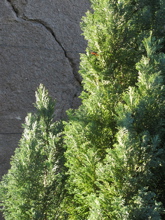 |
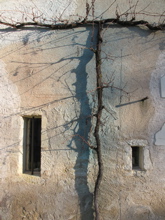 |
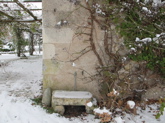 |
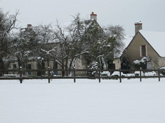 |
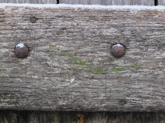 |
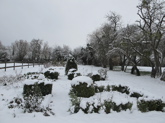 |
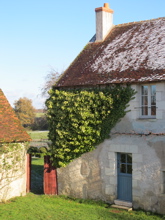 |
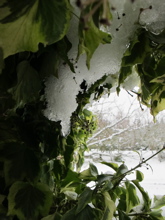 |
 |
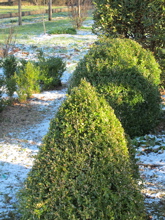 |

…into a silken slice of ambrosia.
‘Tis the season of gourmet delicacies – truffles, oysters and foie gras – perennial stars of les fêtes de fin d’année. The seductive/repellant duality of these acquired tastes is undeniable. There’s an unsettling aspect either to their appearance, texture or how they are produced, which heightens the guilty pleasure of consumption; earthy truffles detected by a pig’s snout, fresh oysters ingested essentially alive, and the incomparably subtle flavor of a force-fed duck’s swollen liver.
Working on French Country Hideaways, which features several properties that produce foie gras and truffles, I stopped short of hands-on involvement. So when friends proposed an atelier foie gras offered by Maison Perrin, a small Touraine producer, I was all in. I always found purchasing foie gras a challenge with so many variations and pricing inconsistencies. Numerous French friends prepare it at home, but I envisioned a complicated ritual.
Maison Perrin is a farm in La Celle Guenand, near Le Grand Pressigny, owned by Valérie and Philippe Charcellay. Its remote location conjured images of a convivial country kitchen with our intimate group gathered round a worn trestle table scattered with earthenware terrines, warmed by the glow of an open hearth. The destination conformed to expectation, as did a modest shop with hand woven baskets suspended from the ceiling, shelves stocked with conserved duck dishes from cassoulet to rillettes and a cold case stacked with vacuum-packed magrets, lobes of foie and jars of foie gras mi-cuit. Maison Perrin
It was startling to discover that the idyllic kitchen was actually a chilly white tile and stainless steel laboratoire, where to match EU standards, the ambiance exuded the charm of a hospital canteen annexed to a morgue. Comfort was not to be part of our experience. The temperature had to be 50 degrees Fahrenheit. I regretted forgoing the long underwear and fur-lined boots I’d considered because of snowy weather. Gloves weren’t an option, but mercifully we got to warm our hands intermittently under a steamy tap.
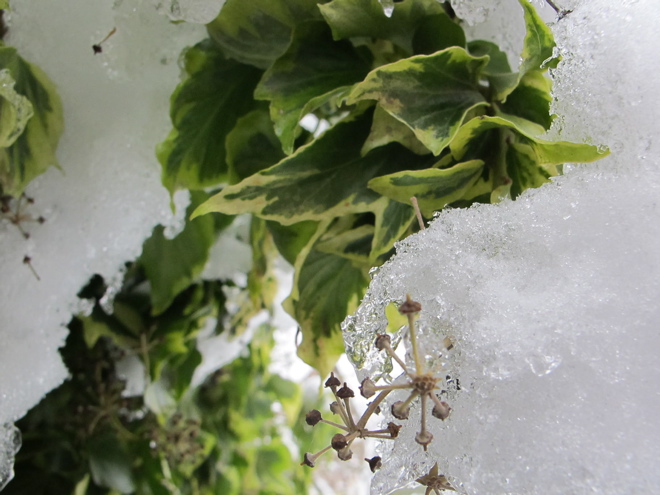
When I moved to NYC after college, the impossible dream was to take over the lease on a rent-controlled apartment. Rent control symbolized mythic, affordable Manhattan before housing ate up half a paycheck – the stuff of urban legend. I never got lucky.
Well, every dog has its day, and I can finally gloat in my rural backwater that I’m grandfathered into EJP, a bargain electricity option which EDF (formerly known as Electricité de France) no longer offers because it’s far too good a deal for the consumer. I’m tempted to be smug, except EJP is a blessing disguised as a curse, and it was more fun when you could bitch about it. Now complaining you can’t do laundry or use your electric oven because it’s an EJP day is considered obnoxious.
EDF created the EJP (Effacement des Jours de Pointe) option for secondary residences, where cold weather consumption occurs (if at all) on weekends and holidays. They offered a very low annual rate, excluding the 22 coldest weekdays of the year, when national consumption peaks and the EJP rate correspondingly spiked. Where EDF miscalculated, was promising not to include weekends, school holidays and the wee hours between 1am and 7am. Read More »
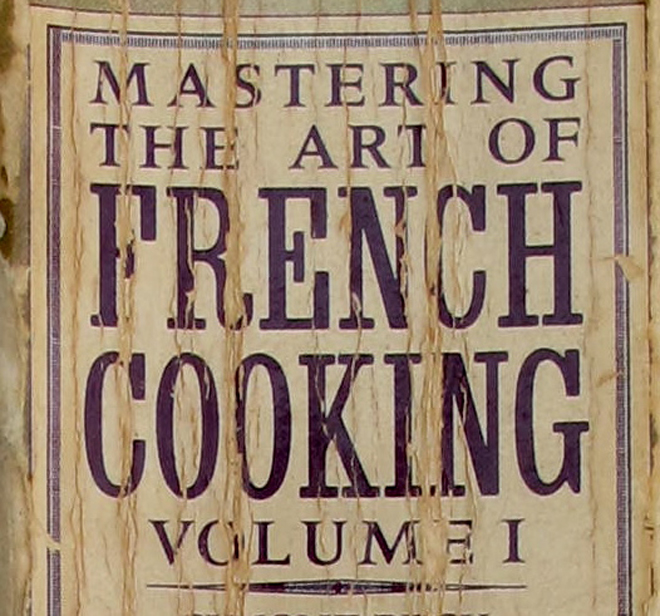
Tuesday November 16, Unesco added the French gastronomic meal to its world heritage roster of intangible cultural treasures. Wednesday, Le Monde.fr published a potpourri of reader responses to the announcement. There was general consensus that the honor recognizes France’s devotion to the convivial meal shared around a table, as much as its rich, varied culinary heritage. lemonde.fr
Le Monde.fr readers readily acknowledged that France doesn’t have a monopoly on gourmet cuisine. Most Mediterranean countries take pride in the quality of their native cooking and the importance of making time to sit down twice a day for a meal shared with family or friends, but as an international symbol of culinary arts and l’art du table, France is unrivaled.
When the subject came up at a dinner we attended Saturday night, guests chimed in. One felt Italian cuisine deserved to be included. The idea was quickly dismissed. “They eat virtually the same thing every day. It’s delicious but they don’t have as much variety as we do”. Italy couldn’t compete in the cheese stakes. Pasta shapes and gelato flavors don’t count and besides, you can sample hundreds of macaroon flavors in Paris. One woman, a psychologist, claimed Unesco was citing the ritual progression of a French meal, “entrée, plat, salade, fromage et dessert”. Infinite variety within the context of a codified set of courses – which was precisely what our meal had been – fish soup, served with croutons and grated cheese followed by filet de boeuf en croute with glazed onions and roast potatoes, green salad, three impeccably ripe cheeses and spiced apple compote with crème anglaise. Coffee naturally served in the salon. Read More »

As with her diet, a French woman’s beauty and grooming regimen tends to be well balanced. She won’t deny herself much, yet consumes in moderation. A realist who plays up her best features rather than obsess over flaws; she accepts that beauty, like an impeccable jardin à la Française, demands consistent maintenance.
Keeping up appearances is a vital tenet of French culture, particularly out in public, which is why my daughters give me the once over before I leave the house, lest I regress to American standards and slip out to the bakery in running sweats. On average, French women over thirty don’t favor conspicuous makeup. Color statements are acceptable for hair dye and pedicures. Glowing skin and alluring eyes are the priority (over 60% of French cosmetic purchases are for foundation and mascara). It’s rare to see women put lipstick on in public, in part because they don’t wear it consistently.
However, teens and young women in their twenties are breaking out of the natural look, experimenting and having fun with bronzing powder, false eyelashes, heavy eyeliner and coats of mascara, plus playful hues of nail enamel. A Re-boot of Bardot in the 6os. Read More »

A chill wind swept over Paris this weekend. Collars were up on coats pulled out for their first sortie of the season, as exuberant sun-burnished limbs of la rentrée went under cover along with fingers, toes, and décolletés.
Leaves scuttling along the pavement past gutters strewn with cigarette butts and vagrant scraps of trash, signaled the idyll of Indian summer had segued into la grogne of strike season…a shift apt to discourage the sunniest of dispositions. Humor being the best revenge, I decided to amuse myself delving into the confidential milieu of luxury lingerie. Read More »

Forget being hung up about your accent. Communication is governed by the rule of subjectivity, with enough opportunity for misinterpretation when speaking in your mother tongue. Having a foreign accent is a universal condition of learning a new language. Embrace yours with pride. Few foreigners who learn new languages as an adult, manage to suppress their accent even when they speak fluently – so accept the inevitable.
However, expect your ego to be challenged. Unless you are supremely thick skinned, letting go of inhibition demands ample reserves of self-esteem, good humor and humility. Keep reminding yourself of the progress you’re making. Focus on practicing as much as possible and refuse to succumb to self-consciousness. Few of us are naturals in more than one domain. If linguistics is yours, terrific, but it probably isn’t, so persistence will have to get you over the hump. Read More »
© Copyright 2025 Casey O’Brien Blondes - Privacy Policy | Design by Weller Smith Design
Do NOT follow this link or you will be banned from the site!